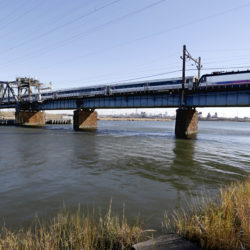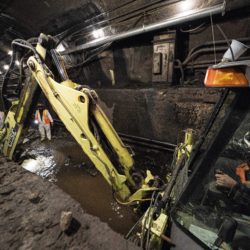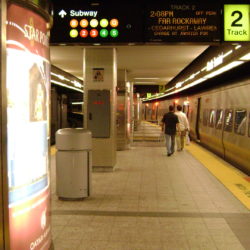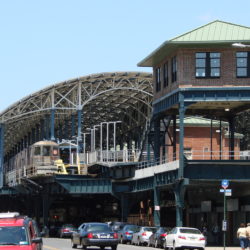
The pros and cons of working remotely from the rails
[ad_1]
In this Oct. 14, 2016 photo, an Amtrak Acela train travels along the shore where people are fishing in Old Saybrook, Conn.
AP photo by Michael Dwyer
Traveling looks a bit different post-pandemic as many people try to balance working remotely with traveling. One consideration for travel is to turn to the rails and hop on a train instead of heading out on an airplane.
Trains can often venture to places neither a plane nor a car can go. But there are many factors to weigh whether train travel will work for working remotely.
Advantages of hitting the rails
Lower carbon footprint – Many travelers are becoming more eco-conscious when planning their trips. According to Vacations By Rail, a travel company dedicated to helping customers book rail vacations, trains are at the top of the list of sustainable travel options.
Trains can produce 41 grams per kilometer per passenger, compared to 133 grams per passenger on a flight. They note, “Making the simple switch from plane to train for your next vacation could lower your environmental impact by as much as 84 percent!”
Cheaper cost and ease of access – Train tickets are typically cheaper than plane tickets, and there is little or no cost for luggage or restrictions on them. The time it takes to prep and board a train is also easier than for a plane.
More space and comfort – Unlike plane travel, where passengers are pretty much confined to their small seats for the duration of a flight, trains have wider seating rows and the freedom to move around between cars. This can be beneficial for a remote worker to take breaks, hit the restroom, and grab snacks.
Carlos Rider, a writer, digital nomad, and author of the blog A Brother Abroad shares that he loves working remotely from trains and has done so in Thailand, the Balkans, Sri Lanka, and Western Europe. He says, “Trains always have more space to work. Not only are the seats and tables on trains more spacious than on planes, but you commonly have other options for working, such as a dining car or different spaces.”
Scenic viewpoints – In addition to ample space, the views from a train are better than simply looking at the clouds and sky from outside the plane window.
Bonnie Whitfield, Human Resources Director for Family Destinations Guide, frequently travels to scout locations and finds taking the train more convenient when working remotely because the journey is just as important as the destination. “There’s nothing quite like hopping on a train and watching the world go by for hours. You get to see so much more of your surroundings than you would on a flight.”
Rider agrees. “The views when traveling by rail are the most beautiful of any mode of travel, easily beating out the window views of air travel and road tripping by car,” he says. “For the average wanderluster working remotely, this peaceful look out the window is just enough to satisfy, calm, and encourage-all while you’re still diligently putting in a reasonable day’s work.”
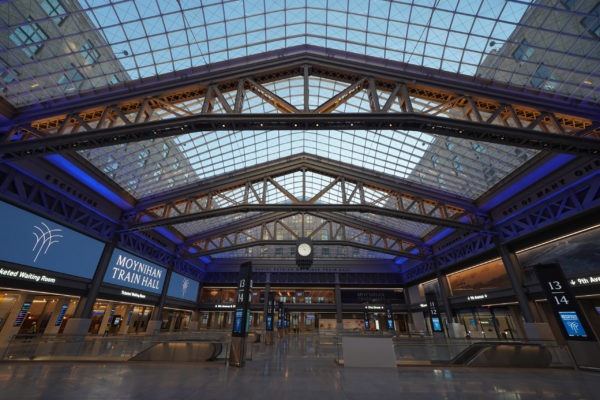
Photo courtesy of NYS Governor’s Office
Obstacles of train travel
While traveling on the train can certainly have its benefits, it doesn’t come without its challenges-ones that remote workers need to think about before embarking on a train journey.
Unreliable Wi-Fi – While most of the time Wi-Fi is more reliable on a train than on a plane (and free), it can sometimes be spotty or unreliable, particularly when heading through a tunnel or remote canyon.
Becca Siegel, the founder of HalfHalf Travel, a blog about remote work, photography, and travel, has experience working on trains. “I’ve had times when Amtrak’s Wi-Fi hardly works and gives an unacceptable level of download and upload speeds. There were times when I could hardly get an email through! My best advice is to have a backup Wi-Fi scenario like a personal hotspot.”
Slower travel than on planes – Train journeys are not intended to be the quickest method of reaching the destination. Planes might better suit workers needing to get to a destination quickly.
Noise level/crowdedness – While there is more space to sit and work on a train, trains can often be more crowded and feature more noise distractions than a plane, making it hard to take a meeting or phone call.
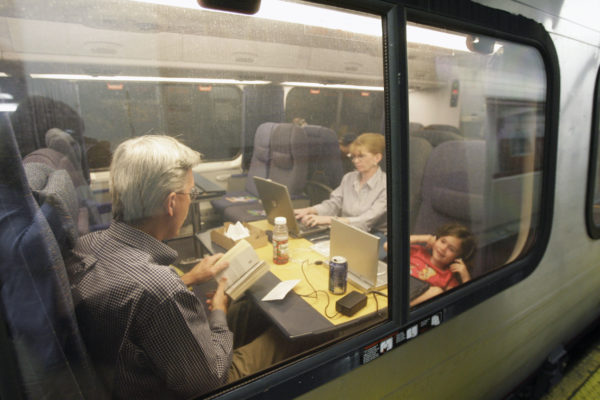
AP Photo/Mary Altaffer
Train Only Destinations
Whether it be stunning coastlines, rugged mountain passes, national parks, or lush forests, there are simply some places only the train can provide the best backdrop for. Oftentimes, the train is the only way to view them.
Various travel publications and experts have compiled some of the best train trips across America and the world. Anyone-including remote workers- should consider adding these to their next travel itinerary.
Thrillist recommends this list of train trips when looking for that exclusive train trip. Additionally, Vacations by Rail features their 25 Must Take Train Trips. Travel and Leisure’s Best National Park Train Trips offers insight on how to visit some of America’s best national parks via the rails.
Smarter Travel offers their choices for America’s best train journeys and five top choices from the World. Lastly, USA Today has ranked their best U.S Train trips, including many notable Amtrak routes.
Keith Terrell, founder and CEO of Backpacks Global, describes his experience on the Glacier Express train through Switzerland, one of the must-see train rides in the world. The train travels through the Swiss Alps and serves full three-course meals, in addition to a plate of the day.
“We were traveling through the Alps with some incredibly beautiful scenes. As a remote worker, the setup was great. I’d get my work done in-between the stops and be able to look up to the window and see a picturesque view,” he says. “It was just the calmest and most exciting workday all in one go. I was a lot more productive too because I wanted to finish my work quickly to be able to enjoy the route completely.”
For the remote worker considering their next voyage, travel by train is worth considering for the ease, convenience, and views offered along the way. Consider the potential of taking the train and plan a future journey along the rails-while working or not.
[ad_2]
Source link

